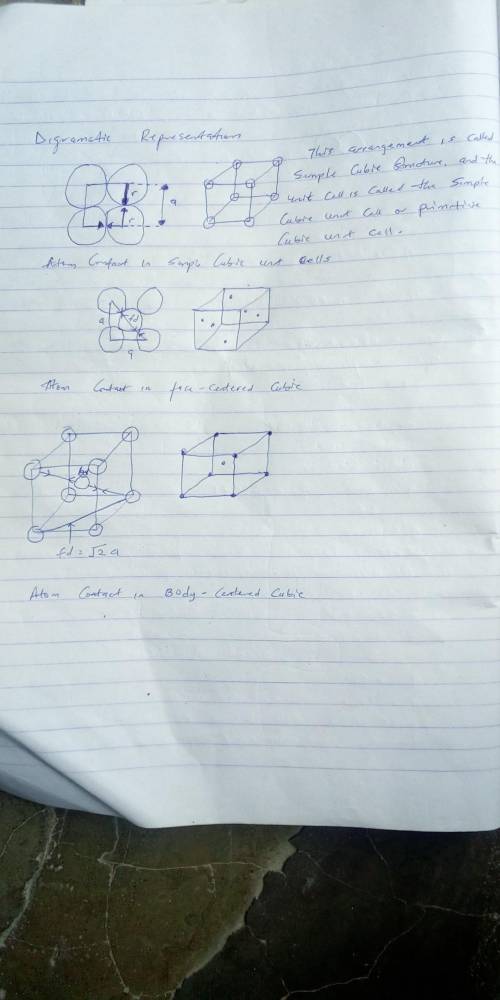
Identify each unit cell as a simple cubic (or primitive-cubic), body-centered cubic, or face-centered cubic unit cell. Face-centered cubic is also known as cubic close‑packed. The first unit cell is a six sided cube with a sphere on each corner and a line along each edge of the cube connecting the center of each sphere with the centers of three other spheres. The second unit cell is a six sided cube with a sphere in the center of the cube, a sphere on each corner, and a line along each edge of the cube connecting the center of each corner sphere with the centers of three other corner spheres. The third unit cell is a six sided cube with a sphere in the center of each face, a sphere on each corner, and a line along each edge of the cube connecting the center of each corner sphere with the centers of three other corner spheres. Dashed lines connect each face sphere with the sphere on the opposite face. Answer Bank

Answers: 2


Another question on Biology

Biology, 21.06.2019 22:00
Which of the following scenarios is an example of the bottleneck effect? answers a in south africa, much of the afrikaner population is descended from a small number of dutch colonists. in this population, this is an unusually high frequency of pseudoxanthoma elasticum (pxe), an elastic tissue disorder. b four white-tailed deer are introduced to a park in finland. thirty years after their introduction scientists compare the genes in the population and find that there is no variation. c during the industrial revolution, london's air became filled with soot. as a result, birds started eating more of the lighter moths because they were easier to spot than their darker counterparts. over time, the moth population changed so that there were more darker moths than lighter ones. d 10% of the population of american alligators in an area have the recessive trait albinism. a massive flood results in the death of 80% of the population. of the remaining population, 60% have the recessive trait of albinism.
Answers: 2

Biology, 21.06.2019 23:00
The tasmanian devil, a marsupial carnivore, is facing extinction due to devil facial tumor disease (dftd) which causes bulging cancerous lumps and lesions to erupt around the face and neck — often causing enough deformation to make seeing or eating difficult. dftd has evolved into a contagious cancer, a trait that is unique among cancers. devil mating behavior involves biting around the head and neck, allowing cells from one individual — especially cells from the crumbly dftd tumors — to be transferred to the wounds or face of a new individual. this marsupial was once found across australia, but sea levels rose, isolating the tasmanian population, while the australian population went extinct. what would be an outcome of genetic isolation that is likely to have impacted the spread of dftd? a) reduced territory puts diseased individuals in greater contact with non-diseased ones. b) inbreeding results in less variation in facial features so the cancer is generally fatal. c) genetic isolation has made it difficult for scientists to develop a vaccine against dftd. d) the lack of genetic variation in the immune system of tasmanian devils minimizes resistance to the disease.
Answers: 3

Biology, 22.06.2019 00:00
Which ideas did your answer contain? check all that apply. no food for organisms no oxygen in the atmosphere no trees or flowering plants no products based on trees or plants (building materials, medicines, fuels, fibers) no fossil fuels
Answers: 2

Biology, 22.06.2019 02:00
Which statements describe resources? one of the factors people use when deciding where they will live is the availability of resources. renewable resources have little value for people. resources are unevenly distributed throughout the world. energy is the world resource which has the highest use. the use of nonrenewable resources has decreased in recent history. the use of resources is evenly distributed throughout the world. the world's oil supply will last for the next forty years if its use continues as expected.
Answers: 3
You know the right answer?
Identify each unit cell as a simple cubic (or primitive-cubic), body-centered cubic, or face-centere...
Questions


Mathematics, 03.03.2021 17:20




History, 03.03.2021 17:20

Mathematics, 03.03.2021 17:20

Mathematics, 03.03.2021 17:20


Spanish, 03.03.2021 17:20


Mathematics, 03.03.2021 17:20











